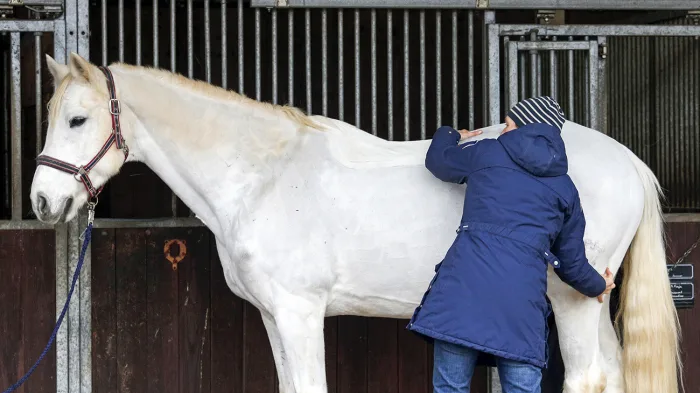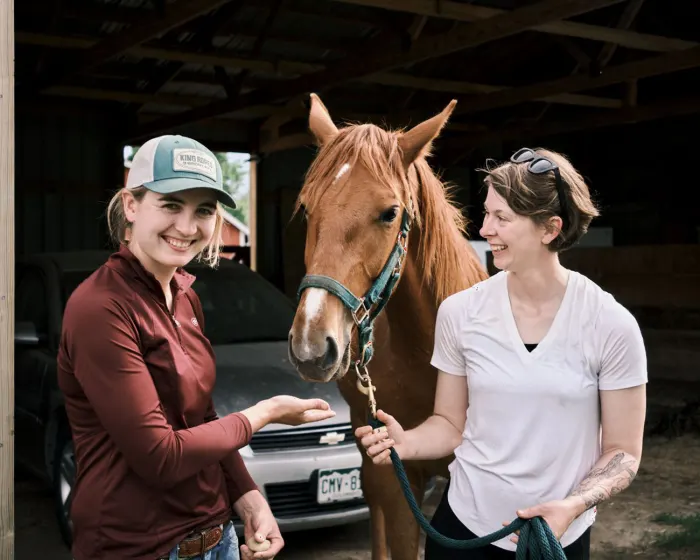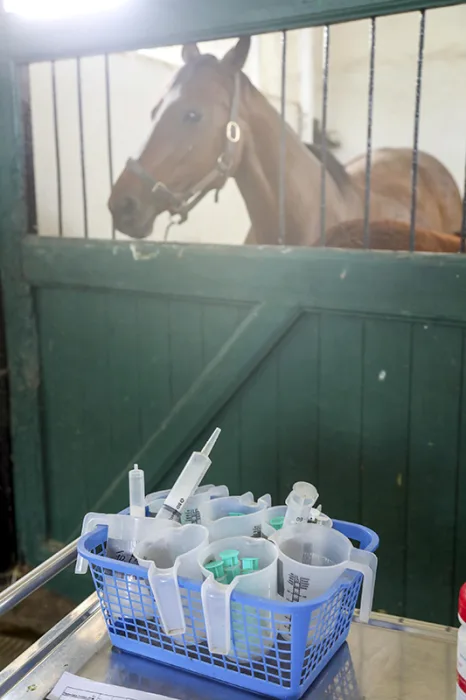Katie Sullivan watched Anna Carroll, DVM, gently rub an ice cube on her draft horse’s neck while whispering softly to him. Carroll’s calming manner and ice-numbing technique enabled her to inject sedation into Castle’s neck, so she then could administer 11 stitches into a gaping wound on his front leg.
That might not seem that amazing. But given that just over a year ago, when Sullivan rescued Castle from a kill lot, he spent months not letting anyone touch him, it’s nothing short of miraculous.
“She took so much time and energy to get to his comfort level. If you try and force this horse, he knows how strong he is. You can’t force Castle to do anything,” said Sullivan, who has two other rescue horses at her Fort Collins, Colorado, ranch. “There’s a serious difference now that she’s left. He was much more tolerant of being touched by her than other vets that come out. I didn’t realize what a remarkable difference it would be.”
The “it” that Sullivan refers to is the Fear Free veterinary curriculum in which Carroll, a 2022 graduate of the Washington State University College of Veterinary Medicine, is certified and of which she’s a strong proponent. Carroll most recently interned with Colorado State University’s Equine Field Service, which is how she met Sullivan.

Carroll’s first interaction with Castle was last October when the gelding contracted West Nile Virus and collapsed with temporary paralysis. After nearly six hours, the team was able to get him back on his feet, and he’s since fully recovered. In the interim, Sullivan scheduled a Fear Free appointment for Castle with Carroll. It made the difference when he suffered the nasty gash on his front leg this spring, and Carroll had to treat him.
“He knew the drill and what the expectations were,” Carroll said. “When it came time for me to actually work on him in a more dangerous setting, it worked.”
A Fear Free-specific appointment enables a horse owner and certified veterinarian to work together to help animals become familiar with a veterinarian and how they handle them, thereby helping increase the animal’s comfort levels and reduce their anxiety when interacting with vets. The appointments are also a time in which owners and veterinarians collaborate on ways the owner can work with their animals at home to further reduce their stress during future, hopefully safer, veterinary appointments.
A 2017 study commissioned by the British Equine Veterinary Association surveyed 620 equine veterinarians and found that British equine vets had one of the top three most dangerous civilian jobs in that country. According to the study’s results, equine veterinarians could expect to experience between seven and eight work-related injuries during a 30-year career, with responders indicating that bruising, fractures and lacerations were the most common injuries, and 29 percent indicating that their legs were the most common injury site while 23 percent indicated the head. The main cause of injury was a kick from a horse’s hind leg (49%), followed by a strike with a forelimb (11%) and crush injuries (5%). Furthermore, approximately 25 percent of those injuries required hospitalization and 7 percent resulted in the veterinarian losing consciousness. “There’s a reason we get hurt. It’s because we’re not paying attention to what the horse is telling us,” said Carroll by phone as she drove across the country to the University of Georgia, where she’s beginning a residency in pain management and anesthesia. “Fear Free is a way to keep my students safe, keep myself safe, keep clients safe, and just keep everything mellow. To me, it’s a win-win. There’s always a way to incorporate it into interactions with your horse.
“It’s something I literally apply every day,” Carroll added. “It’s a value set for me, and a way of communicating with horses and with clients. The Fear Free approach is all about how you approach the horse and communicate with them. Everything you do, you’re doing under a threshold, so the horse isn’t getting increasingly anxious. It’s a philosophy as much as behavior modification.”

Established in 2016 by Marty Becker, DVM, a longtime resident veterinary contributor on “Good Morning America” who’s been dubbed “America’s Veterinarian,” the Fear Free online curriculum aims to educate veterinary and pet professionals, animal welfare communities, and pet owners about how to correctly interact with animals to cause them the least amount of stress, anxiety and potential trauma.
“There are tons and tons of horse owners out there who are looking for more information and are open to understanding how to work with their horses better. We need to make sure a horse is valued as a soul, as a being. Horses appreciate that and do respond,” said Carroll.
More than 250,000 people have earned Fear Free certification across 77 countries. Currently 13 U.S. veterinary schools require their students to complete Fear Free certification—including CSU, WSU and Purdue University (Indiana). Additionally, nine other schools highly recommend their students to pursue the curriculum, which is free for veterinary students and instructors.
Approved by the American Association of Veterinary State Boards Registry of Approved Continuing Education, it offers courses for veterinary professionals and practices, pet owners, and other pet and shelter professionals. The courses are written by veterinary and pet experts from around the globe, including boarded veterinary anesthesiologists, behaviorists, and internists; pain experts; veterinary technicians; and experts in shelter medicine, animal training, grooming and boarding.
Additionally, Fear Free members can avail themselves of nearly 60 hours of continuing education once they complete their curriculum, and they also can participate in social media groups and online discussions with Fear Free hosts.
ADVERTISEMENT
Becker, an adjunct professor at his alma mater, WSU’s College of Veterinary Medicine, is the author of 25 books that have sold more than 8 million copies, including three New York Times bestsellers. He said the roots of Fear Free stem from his earliest days growing up on a ranch in Southern Idaho with cows, horses, chickens and myriad other animals.
“I lived in a time when all of the dairy cows had names,” Becker said from his Almost Heaven Ranch in Northern Idaho, where he lives with his wife of 45 years, Teresa Becker, an animal massage therapist and longtime horsewoman. “My dad taught me to respect all animals.”
Marty recalls that as a youngster, he tried to rush through his designated chore of collecting eggs by scaring the chickens that hadn’t gotten off their roosts. His dad caught him.
“He said, ‘Was it efficient? Yes. But that’s not the way we do things. You treat animals well,’ ” Marty said with a chuckle.
Marty then went to veterinary school, where he said animals were often treated roughly, and students were taught to use restraints. While that method was designed to protect people, Marty noticed it had an adverse effect on the animals.
In 2009, he attended a professional conference in Canada to deliver a keynote address, where he then listened to another keynote speech by Karen Overall, VMD, discussing how permanent damage occurs to an animal’s brain because of pain and disturbances. Overall is a renowned expert in animal behavior and neurobehavioral genetics of dogs.

“She changed my life,” Marty said, recalling how he began ruminating on a point Overall had raised, which is that it used to be the norm for humans to also be “restrained” when seeking medical care, resulting in fear and anxiety. He began remembering how he was held down as a youngster, by three people, while a festering splinter was removed from his thumb and how his sister used to have her ponytail pulled at the dentist to remind her to keep her mouth open, “like a human Pez dispenser.”
It was then that the seeds of Fear Free began germinating, building upon his childhood foundation, with Marty arriving at three main tenets: touch gradient, gentle control and considerate approach.
Touch gradient refers to touching animals initially in less sensitive areas, to get them used to it, and then maintaining contact with their bodies while you move around to other areas.
“At the withers, you scratch and let them know you’re a friend,” said Stacie G. Boswell, DVM, DACVS-LA. She’s one of the authors of the equine Fear Free modules and of the “Ultimate Guide For Horses In Need.”
She said you then can slide your hands down their legs and around their body. By starting gently and earning their trust, you’re then able to perform potentially painful actions, such as palpitation of an injured area. “It allows animals to get used to being handled before you need to do more invasive things,” she said.
Gentle control doesn’t necessarily refer to physical control, Boswell said, but rather, getting the animal into positions that allow you to do what you need safely, such as being able to take them in and out of stocks.
“Instead of holding the halter really tight and putting a twitch on them, let them eat while you’re drawing blood,” said Boswell, a 2009 graduate of the Virginia-Maryland Regional College of Veterinary Medicine who is part of Hardaway Veterinary Hospital, a mixed-animal practice in Belgrade, Montana. “Stress, physiologically, is also pain, and that goes hand in hand with how [animals] heal.”
The third tenet, considerate approach, encompasses how you interact with an animal, taking into account their surroundings and environment, such as going from light to dark, putting their head down to sniff, being separated from their herd friends, flies or other pests nearby, and being subjected to the fear pheromones excreted by previous clients in a clinic. A simple yet impactful example of considerate approach revolves around the use of needles.
“Size matters,” Boswell said. “Using the smallest needle possible for everything we do is a considerate approach. How can we make things more comfortable for the horse? It’s about being considerate and mindful of what the horse’s needs are.
ADVERTISEMENT
“Instead of each of us learning tips and tricks from different mentors, Fear Free pulls them all together,” Boswell added. “It provides education about understanding body language, what the horses are saying, how they’re feeling at any given time, what signals they’re transmitting, so everyone can stay safe, and horses aren’t startled. A lot of times, people just don’t understand it and see it from the horse’s perspective. It starts to seem really logical when you start thinking about it.”
Other examples of ways in which veterinarians and handlers can use a considerate approach and gentle control include the use of lidocaine in jelly before tubing a horse and to numb an injection site—similar to Carroll’s ice-cube approach—and using food correctly to encourage a horse to relax.
“If you’ve got to give wormer or an injection, use a distraction technique,” Marty said. “Give them something on the front end that’s very tasty. These foods you give must be novel in that they’re special but not so novel that they’ve never tasted it. You want something that the horse doesn’t get that often that’s really tasty.”
“It’s not just about reducing their anxiety, pain and stress but about increasing their happiness and calmness.”
Dr. Marty Becker
On his own farm, he saves Cosmic Crisp apples for such occasions. “We feed a lot of carrots, mints, and apples, but we only use the Cosmic Crisps when we’re going to be doing something where they’ll have a heightened sense of stress. It’s like the doctor giving lollipops to kids,” Marty said.
He emphasized that rather than it seeming to reinforce bad behavior, which many people think feeding treats might do, it’s assuaging the fear reaction a horse is having and morphing it into a good experience.
“You’ve got to be attuned to their body language, and you always must take steps to reduce their anxiety and stress,” Marty said, adding that he also supports the use of pharmaceuticals. “Think of sedation early and often. Think of sedation as a first option and not a last resort.”
For example, he administers Zylkene, a behavior supplement made from a milk protein, to one of his horses who suffers from trail anxiety after a ride in which another horse got caught up in barbed wire, and he also likes to rub buprenorphine gel on a horse’s gums before farrier visits to help take the edge off.
“Once you’ve learned it, watched it, done it, you’re not going to want to go back to something else,” Marty said.
Marty, Boswell and Carroll all pointed to how many horse owners they encounter who are eager for more knowledge about how they can increase their animals’ comfort levels and reduce their anxiety when they’re being handled, and to interact with veterinarians who are trained in the Fear Free tenets.
“The public wants us to look not just at the physical well- being of their animals but also their mental well-being,” Marty said. “It’s not just about reducing their anxiety, pain and stress but about increasing their happiness and calm- ness. There are just so many things you can do.”
Boswell agreed: “The more tools we have in our toolbox, and the better we can use those tools, the better we can interact with horses. What’s cool about Fear Free is that there’s something for everyone in it.”
This article originally appeared in the September 2023 issue of The Chronicle of the Horse. You can subscribe and get online access to a digital version and then enjoy a year of The Chronicle of the Horse and our lifestyle publication, Untacked. If you’re just following COTH online, you’re missing so much great unique content. Each print issue of the Chronicle is full of in-depth competition news, fascinating features, probing looks at issues within the sports of hunter/jumper, eventing and dressage, and stunning photography.














